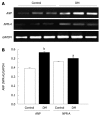Atrial natriuretic peptide signal pathway upregulated in stomach of streptozotocin-induced diabetic mice
- PMID: 20039448
- PMCID: PMC2799916
- DOI: 10.3748/wjg.v16.i1.48
Atrial natriuretic peptide signal pathway upregulated in stomach of streptozotocin-induced diabetic mice
Abstract
Aim: To investigate atrial natriuretic peptide (ANP) secretion from gastric mucosa and the relationship between the ANP/natriuretic peptide receptor type A (NPR-A) pathway and diabetic gastroparesis.
Methods: Male imprinting control region (ICR) mice (4 wk old) were divided into two groups: control mice, and streptozotocin-induced diabetic mice. Eight weeks after injection, spontaneous gastric contraction was recorded by using physiography in control and streptozotocin-induced diabetic mice. The ANP-positive cells in gastric mucosa and among dispersed gastric epithelial cells were detected by using immunohistochemistry and flow cytometry, respectively. ANP and natriuretic peptide receptor type A (NPR-A) gene expression in gastric tissue was observed by using the reverse transcriptase polymerase chain reaction.
Results: The frequency of spontaneous gastric contraction was reduced from 12.9 +/- 0.8 cycles/min in the control group to 8.4 +/- 0.6 cycles/min in the diabetic mice (n = 8, P < 0.05). However, the amplitude of contraction was not significantly affected in the diabetic group. The depletion of interstitial cells of Cajal in the gastric muscle layer was observed in the diabetic mice. ANP-positive cells were distributed in the gastric mucosal layer and the density index of ANP-positive cells was increased from 20.9 +/- 2.2 cells/field in control mice to 51.8 +/- 2.9 cells/field in diabetic mice (n = 8, P < 0.05). The percentage of ANP-positive cells among the dispersed gastric epithelial cells was increased from 10.0% +/- 0.9% in the control mice to 41.2% +/- 1.0% in the diabetic mice (n = 3, P < 0.05). ANP and NPR-A genes were both expressed in mouse stomach, and the expression was significantly increased in the diabetic mice.
Conclusion: These results suggest that the ANP/NPR-A signaling pathway is upregulated in streptozotocin-induced diabetic mice, and contributes to the development of diabetic gastroparesis.
Figures




Similar articles
-
Gastric nNOS reduction accompanied by natriuretic peptides signaling pathway upregulation in diabetic mice.World J Gastroenterol. 2014 Apr 28;20(16):4626-35. doi: 10.3748/wjg.v20.i16.4626. World J Gastroenterol. 2014. PMID: 24782615 Free PMC article.
-
Natriuretic peptide-dependent cGMP signal pathway potentiated the relaxation of gastric smooth muscle in streptozotocin-induced diabetic rats.Dig Dis Sci. 2010 Mar;55(3):589-95. doi: 10.1007/s10620-009-0766-8. Epub 2009 Mar 7. Dig Dis Sci. 2010. PMID: 19267196
-
Downregulation of the atrial natriuretic peptide/natriuretic peptide receptor-C system in the early stages of diabetic retinopathy in the rat.Mol Vis. 2005 Mar 18;11:216-24. Mol Vis. 2005. PMID: 15789000
-
C-type natriuretic-peptide-potentiated relaxation response of gastric smooth muscle in streptozotocin-induced diabetic rats.World J Gastroenterol. 2009 May 7;15(17):2125-31. doi: 10.3748/wjg.15.2125. World J Gastroenterol. 2009. PMID: 19418585 Free PMC article.
-
Natriuretic peptides as regulatory mediators of secretory activity in the digestive system.Regul Pept. 2009 Apr 10;154(1-3):5-15. doi: 10.1016/j.regpep.2009.02.009. Epub 2009 Feb 20. Regul Pept. 2009. PMID: 19233231 Review.
Cited by
-
Gastric nNOS reduction accompanied by natriuretic peptides signaling pathway upregulation in diabetic mice.World J Gastroenterol. 2014 Apr 28;20(16):4626-35. doi: 10.3748/wjg.v20.i16.4626. World J Gastroenterol. 2014. PMID: 24782615 Free PMC article.
-
NPs/NPRs Signaling Pathways May Be Involved in Depression-Induced Loss of Gastric ICC by Decreasing the Production of mSCF.PLoS One. 2016 Feb 10;11(2):e0149031. doi: 10.1371/journal.pone.0149031. eCollection 2016. PLoS One. 2016. PMID: 26862759 Free PMC article.
-
Early Adaptation of Small Intestine After Massive Small Bowel Resection in Rats.Iran J Pediatr. 2015 Aug;25(4):e530. doi: 10.5812/ijp.530. Epub 2015 Aug 24. Iran J Pediatr. 2015. PMID: 26396708 Free PMC article.
References
-
- Koch KL. Diabetic gastropathy: gastric neuromuscular dysfunction in diabetes mellitus: a review of symptoms, pathophysiology, and treatment. Dig Dis Sci. 1999;44:1061–1075. - PubMed
-
- Kuo P, Rayner CK, Jones KL, Horowitz M. Pathophysiology and management of diabetic gastropathy: a guide for endocrinologists. Drugs. 2007;67:1671–1687. - PubMed
-
- Itaba S, Chijiiwa Y, Matsuzaka H, Motomura Y, Nawata H. Presence of C-type natriuretic peptide (CNP) in guinea pig caecum: role and mechanisms of CNP in circular smooth muscle relaxation. Neurogastroenterol Motil. 2004;16:375–382. - PubMed
-
- Ordog T. Interstitial cells of Cajal in diabetic gastroenteropathy. Neurogastroenterol Motil. 2008;20:8–18. - PubMed
-
- Parkman HP, Hasler WL, Fisher RS. American Gastroenterological Association medical position statement: diagnosis and treatment of gastroparesis. Gastroenterology. 2004;127:1589–1591. - PubMed
Publication types
MeSH terms
Substances
LinkOut - more resources
Full Text Sources
Miscellaneous

